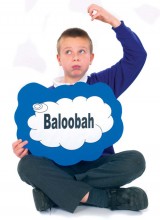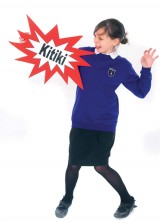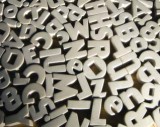Playing with nonsense words has much value when learning about language, says Steve Bowkett
In approaching this subject with children it’s worth kicking off with the question, ‘When is a word a nonsense word?’ The answer an adult might give is that it’s any word having no agreed meaning; a made-up word that makes no sense (hence non-sense). Exploring a little further however we might agree that for many children most of the words they hear or see are nonsense words insofar as their meanings are unknown to them. Also, and ironically, all words have been made up at some point and no doubt by many routes have come to take on broadly agreed meanings. Having said that, the foundations of philosophical enquiry and a great deal of time and effort in the legal profession are built on the notion that while words, phrases and sentences can be meaningful those meanings cannot be assumed; rather, various interpretations must be explored so that some kind of consensus can be reached.
 So already (to me anyway) the idea of ‘nonsense’ words fascinates. But I came to realise that the topic is important in the classroom when I noticed that a girl had written down a learning objective in her literacy book. I asked her what the sentence meant and she couldn’t tell me. During the same workshop session one of her classmates, Ben, had written that ‘The midnight sky was pitch black.’ I asked the children what ‘pitch’ meant here and none of them knew for sure. Even when I prompted by wondering whether it meant very black, quite black, bluish-black etc they didn’t actually know. So is ‘pitch’ a nonsense word as far as the children are concerned? Whether you feel that it is or not, I find it troubling that children tend not to question and explore the meanings of the words they use.
So already (to me anyway) the idea of ‘nonsense’ words fascinates. But I came to realise that the topic is important in the classroom when I noticed that a girl had written down a learning objective in her literacy book. I asked her what the sentence meant and she couldn’t tell me. During the same workshop session one of her classmates, Ben, had written that ‘The midnight sky was pitch black.’ I asked the children what ‘pitch’ meant here and none of them knew for sure. Even when I prompted by wondering whether it meant very black, quite black, bluish-black etc they didn’t actually know. So is ‘pitch’ a nonsense word as far as the children are concerned? Whether you feel that it is or not, I find it troubling that children tend not to question and explore the meanings of the words they use.
So how can we help children to question and explore? Utilising nonsense words is one practical and enjoyable way of doing so.
Firstly and most importantly, when we encourage children to play with nonsense words we’re cultivating an attitude towards language generally. Here’s a game you can try immediately.
 Ask the children to look at the images below. Tell them that one of the shapes is called a baloobah and the other is called a kitiki. Which shape is the baloobah?
Ask the children to look at the images below. Tell them that one of the shapes is called a baloobah and the other is called a kitiki. Which shape is the baloobah?
Most children will pick the left-hand image. The names of the shapes are nonsense words, so how did the children decide which was which? Here are some of the replies you might receive…
• The baloobah is round like a balloon.
• It’s kind of soft and cloudy. (Notice how children move their hands when the describe the baloobah.)
• The kitiki is all spiky and prickly and it doesn’t fit the word ‘baloobah’.
Then you can point out that the word baloobah has lots of round letters in it, and that to say them our mouths make round shapes. Also, we tend to use our hands to ‘mould’ the baloobah shape in the air. Ask for similar sorts of words (nonsense or otherwise). You might get cloud, ball, globe, world, round, boom among others.
Mention too that the word kitiki has plenty of ‘sticky, spiky’ letters that you also find in words such as stick, spike, twig, pin, prick, nail etc.
Highlight how the children are exploring these words.
• By noticing how letter shapes and sounds are linked.
• By making comparisons with other words that are similar in terms of letter shapes and sounds.
• By being ‘body aware’ – noticing how the mouth and hands move etc.
Investigate how these strategies work with other letter and sound combinations. For instance:
• The ‘wh’ blend in words like whistle, whoosh, whirl, whip. Notice how these are ‘breathy’ and suggest movement in the air. Point out that to get ready to say the word ‘whistle’ we shape our mouths as though we were actually about to whistle. Ask the children to make up nonsense words that follow this pattern.
• The hard c and r of ‘cr’ invites us to use our hands to crush, crumble, crack, crackle and crumple.
• The ‘sp’ blend suggests liquid escaping under pressure as in spray, spurt, spatter, splash, sprinkle, splatter, spit (and notice how we do tend to spurt out a little spray of spittle when we say these words).
In our language many words can morph into different parts of speech. Nouns can turn into adjectives, which can be used as verbs etc. Play the morphing game using nonsense words. Look, for example, at the word GLOMBOUS.
Is it a kitiki-type word or a baloobah-type word? How do you know? Ask the children to use the word in a sentence. It’s likely this will reveal ‘glombous’ to be an adjective (one child added confidently that to make it a noun you’d have to say it ‘Glomb’, plural ‘glombs’). Now play with the word. If you could hold some glombous stuff in your hands, how would it feel? What colour is it? How does it weigh? If you threw it at the wall, what would happen?
Here are some more nonsense words to try out in the same way:
| reebs | snoodled | screamsome |
| swirlwind | grasting | churdling |
| squeshy |
Even though these are made up words we can make sense of them. Not only do they comply to the rules of grammar (snoodled is obviously a past tense verb for instance) but our ‘physiological response’ or body awareness of the words helps us to understand them at a deeper level.
 The poet Dylan Thomas spoke of a ‘thistly wind’. Ask the children to imagine that wind. What does it feel like? (Notice how some children will huddle themselves up and rub at their arms etc). Now change the adjective – what does a candyfloss wind feel like? A grasting wind? A screamsome wind? A vanilla wind?
The poet Dylan Thomas spoke of a ‘thistly wind’. Ask the children to imagine that wind. What does it feel like? (Notice how some children will huddle themselves up and rub at their arms etc). Now change the adjective – what does a candyfloss wind feel like? A grasting wind? A screamsome wind? A vanilla wind?
These metaphors have a direct and powerful effect on our imaginations, partly because of our physical reactions. As one Y5 boy said to me ‘Your imagination isn’t just in your head, it goes all the way through you’. This, I feel, is why nonsense words are often not so nonsensical after all.
Steve Bowkett writes children’s fiction and educational books on literacy, creativity and thinking, and emotional resourcefulness. He hopes that most of what he has to say is not nonsense.
The learning benefits of playing with nonsense words include…
 • Increased confidence in engaging with language.
• Increased confidence in engaging with language.
• Developing ability to make creative connections.
• Deeper insights into the way language links with meaning.
• Greater sensitivity to unorthodox use of language, for instance in poetry.
• Leading to more vivid and powerful descriptive writing.
• Heightened tolerance of ambiguity.
• Increasing readiness to question and challenge meaning.
Kindness is contagious - give your colleagues a boost by recognising their efforts
Ace-Classroom-Support
KS2 Lesson plan: China and Buddism
Ace-English
If your marking doesn’t affect pupil progress - stop it!
Ace-Classroom-Support
